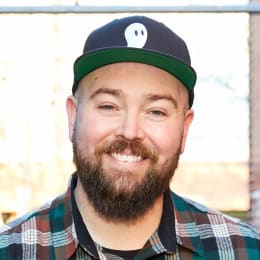Intention vs. Drift
There are two ways to create. Either we intentionally make progress toward goals, or we drift & see what happens. For best results, I think we need both.

How do things happen??
Do people make things happen? Or do things just happen around us and we make the best of it?
I had the pleasure of talking to Dan Mall about, among other things, how design systems get created. In his experience, systems are created through a blend of deliberate effort and the emergent processes of necessity and use.
Dan said this in the context of design systems, but I've been thinking about it ever since.
Everything is influenced by both deliberate and emergent behavior.
In our lives, our careers, and our relationships, we're able to intentionally create outcomes through deliberate effort. But we also have plenty of things that emerge in our lives without any conscious input — they drift into existence over time.
My first instinct was to make a plan to prevent things from drifting. After all, anything we're not intentional about is a risk, right? I want to be the author of my own story, and the idea of just letting things happen feels like handing over control.
The first problem with this is that it's completely unrealistic to try and be intentional about everything. There are too many moving parts, too many variables, and too much context for it to be possible.
But beyond that, Dan said something about design systems that changed how I think about things now: letting people solve problems and identifying patterns before acting, rather than trying to predict behavior in unknown scenarios, leads to better outcomes.
Let's talk about that using the shorthand "intention" and "drift".

Intention is deliberate action toward a defined goal.
"Intention" describes thoughtfully planned, carefully executed tasks that accumulate into a polished, finished outcome.
This is what we talk about almost exclusively in the context of personal development and business alike. We research; we plan; we execute. In fact, prior to this conversation, I'm fairly convinced I thought only intentional work would lead to any meaningful outcome.

Drift is unstructured exploration and observation.
Even without intention, though, things continue to happen. Left alone, patterns and habits emerge in our own behavior and in the culture of teams.
"Drift" describes outcomes that aren't driven by any deliberate action or plan. Drifting is what we get when we decide to let things happen and see where we end up.
There's value in both intention and drift.
I spent the majority of my life as a firm believer in The Plan™. I created The Plan™ and I needed to Follow The Plan™ and I would achieve Success According To The Plan™.
If I tally up the pivotal moments for myself, however, I can't help but acknowledge that — both professionally and personally — drift has accounted for as much of my growth and momentum as intentional efforts. In fact, a few of the most pivotal moments in my life resulted from drifting:
- I learned to code because I was in a band and needed to build a website and customize our MySpace page. When the band broke up, I realized I'd accidentally built enough of a skill set to work professionally as a web developer.
- Starting Learn With Jason was a happy accident. I was experimenting with ideas for how to be more transparent about my work, and invited Nader Dabit to get on a Zoom call and teach me how to use software he was working on. The format worked, so I kept setting up "one more session" with other guests — the show has continued to evolve and I'm about to cross 200 episodes.
- I met my partner, Marisa, in a period of my life when I was "absolutely not dating anyone because I'm moving away soon". We both had no intentions of getting into a relationship, and had multiple conversations early on about how nothing serious would happen between us. That was seven years ago, and we're still together (but, in fairness, we're rarely serious).
For all that I've told myself I followed The Plan™, I'd be lying if I said I knew I'd end up where I am today. A huge amount of my life and my career has emerged as a result of drifting, and I'm extremely happy with the outcomes.
Be intentional when the goal is clear.
If you know where you want to go, being intentional is important. Identifying a clear outcome, making a plan, and executing that plan is the most predictable way to get where you want to go.
However, it's not always clear what the goal is, and that creates a challenge. Trying to be intentional when the requirements are unclear doesn't have the same payoff; you're pushing hard toward somewhere, but it's a lot of hard work going toward an unknown destination.
Drifting allows for discovery and cultivation.
In situations without clear goals, drifting allows us to exist in a space and see how things interact. If we give ourselves the space to observe how a situation is playing out, we start to learn more about it, and gathering more information gives us the confidence we need to clearly identify our next goal.
Sometimes we should drift . . . intentionally.
If it's unclear where you want to go, drifting can be a deliberate choice that leads to better clarification.
If we want to do something well, whether it's passing a test or learning a new skill, we can vastly improve our chances by studying. With something like a test, how we do this is pretty straightforward — but how do we "study" being successful, being happy, or building a great team?
By choosing to drift for a while instead of trying to make a plan immediately, we get a chance to "study" our environment by existing in it without an agenda. We can ask ourselves questions to gather information:
- Where is my energy and happiness coming from?
- What do I find draining or demotivating?
- Do I enjoy the work I'm doing?
- Where are the biggest opportunities for growth?
- Are there patterns to my (or my team's) behavior?
- What do I wish I was doing that I'm not doing now?
By drifting, we can free up our mental bandwidth to ask questions and let patterns and opportunities emerge. Once we have enough information, we can switch back over to being intentional and make a plan to turn the opportunities into growth.
Balancing intention and drift is important.
Embracing both intention and drift can give us the ability to deliberately make progress toward our concrete goals while also allowing us the space to notice new opportunities.
We can be both the authors of our story and a curious observer. Recognizing when we should adopt one or the other approach can help us avoid frustration and risk.
And, for me at least, it's led to a happy life that I've both worked hard to build and stumbled face-first into.